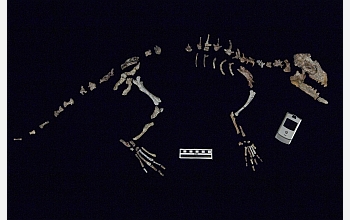News Release 07-188
Missing Link Between Whales and Four-Footed Ancestors Discovered
December 20, 2007
This material is available primarily for archival purposes. Telephone numbers or other contact information may be out of date; please see current contact information at media contacts.
Scientists have discovered the missing link between whales and their four-footed ancestors. The result is reported in this week's issue of the journal Nature. The research is funded by the National Science Foundation (NSF).
Scientists since Darwin have known that whales are mammals whose ancestors walked on land. In the past 15 years, researchers led by Hans Thewissen of the Northeastern Ohio Universities Colleges of Medicine and Pharmacy (NEOUCOM) have identified a series of intermediate fossils documenting whale's dramatic evolutionary transition from land to sea.
But one step was missing: The identity of the land ancestors of whales.
Now Thewissen and colleagues have discovered the skeleton of Indohyus, an approximately 48-million-year-old even-toed ungulate from the Kashmir region of India, as the closest known fossil relative of whales.
"The evolution of whales is a tale of the adaptation of a land-based mammal to increasingly aquatic environments," said H. Richard Lane, program director in NSF's Division of Earth Sciences. "This recent discovery provides us with a new understanding of this near-shore-dwelling, shallow-water ancestor."
Thewissen's team studied a layer of mudstone with hundreds of bones of Indohyus, a fox-sized mammal that looked something like a miniature deer. They report key similarities between whales and Indohyus in the skull and ear that show their close family relationship. They also explored how Indohyus lived and came up with some surprising results. They determined that the bones of the skeleton of Indohyus had a thick outside layer, much thicker than in other mammals of this size. This characteristic is often seen in mammals that are slow aquatic waders, such as the hippopotamus today.
Indohyus' aquatic habits are further confirmed by the chemical composition of their teeth, which revealed oxygen isotope ratios similar to those of aquatic animals. All this implies that Indohyus spent much of its time in water.
Before, it was often assumed that whales descended from carnivorous terrestrial ancestors, and some researchers speculated that whales became aquatic to feed on ocean-dwelling fish. According to Thewissen, "Clearly, this is not the case, as Indohyus is a plant-eater, and already is aquatic. Apparently the dietary shift to hunting animals (as modern whales do) came later than the habitat shift to the water."
One modern mousedeer offers something of an analogue to the ancient Indohyus, even though it is not closely related to whales: The African Mousedeer (also called Chevrotain) is known to jump in water when in danger, and move around at the bottom.
"Not much was known about the earliest whales until the early 1990s," Thewissen said. "But then, a number of discoveries came in quick succession."
The discovery of the first, and at that point only, amphibious whale, Ambulocetus natans, was published in Science by the Thewissen's team in 1994. In 2001, Thewissen's team discovered the skeleton of Pakicetus attocki, the oldest known whale, and published it as a cover-story in Nature. Pakicetus and Ambulocetus represent the two earliest stages of whales, and Indohyus complements this by showing it what the ancestors of whales looked like.
-NSF-
Media Contacts
Cheryl Dybas, NSF, (703) 292-7734, email: cdybas@nsf.gov
Mark Bosko, Northeastern Ohio Universities, (330) 325-6673, email: mbosko@neuocom.edu
The U.S. National Science Foundation propels the nation forward by advancing fundamental research in all fields of science and engineering. NSF supports research and people by providing facilities, instruments and funding to support their ingenuity and sustain the U.S. as a global leader in research and innovation. With a fiscal year 2023 budget of $9.5 billion, NSF funds reach all 50 states through grants to nearly 2,000 colleges, universities and institutions. Each year, NSF receives more than 40,000 competitive proposals and makes about 11,000 new awards. Those awards include support for cooperative research with industry, Arctic and Antarctic research and operations, and U.S. participation in international scientific efforts.
Connect with us online
NSF website: nsf.gov
NSF News: nsf.gov/news
For News Media: nsf.gov/news/newsroom
Statistics: nsf.gov/statistics/
Awards database: nsf.gov/awardsearch/
Follow us on social
Twitter: twitter.com/NSF
Facebook: facebook.com/US.NSF
Instagram: instagram.com/nsfgov



